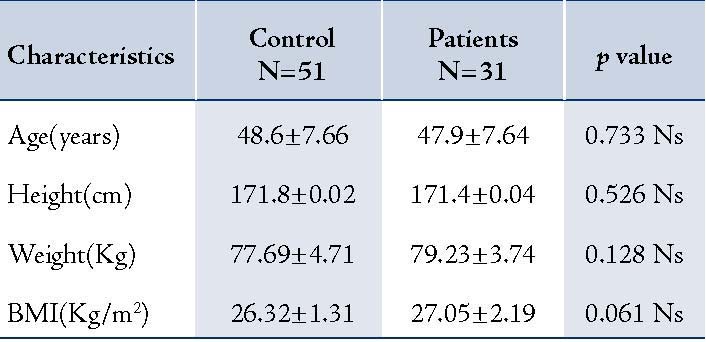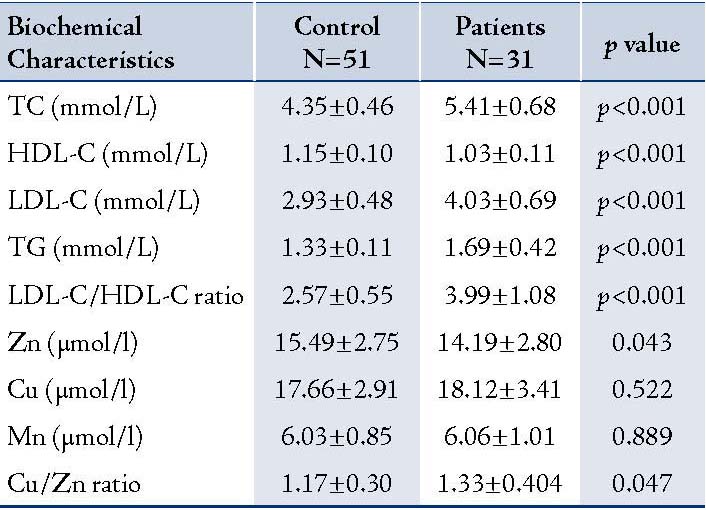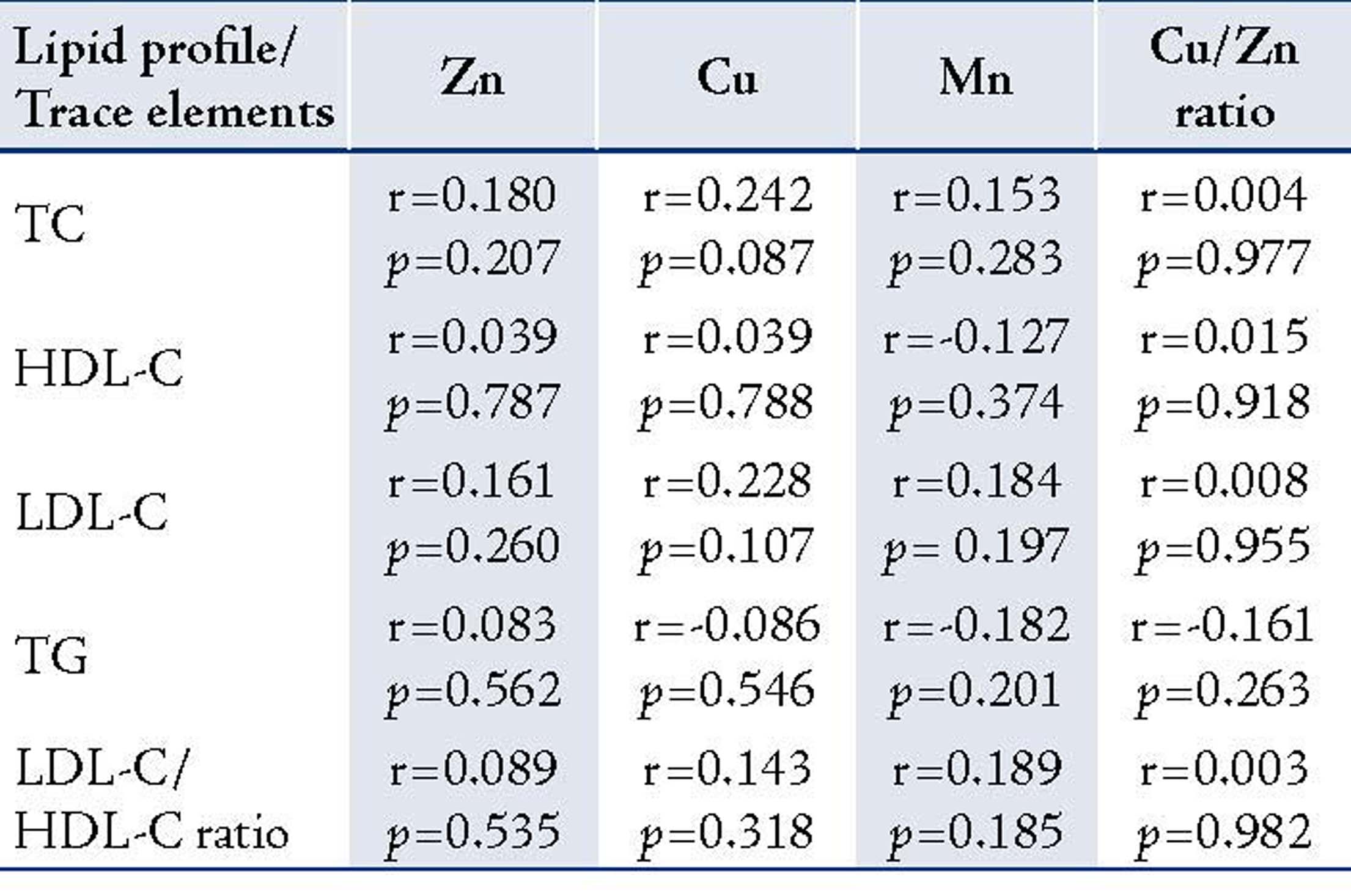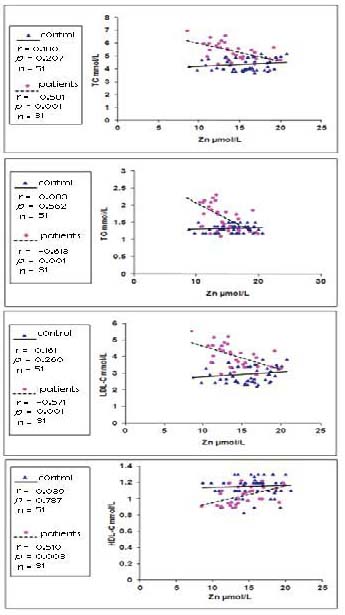|
Abstract
Objectives: To evaluate the correlations of the serum concentrations of copper, zinc, and manganese with lipid profile parameters of adult men in Mosul City, Iraq.
Methods: The study included 51 apparently healthy adult men as a control group aged 34-62 years (group 1), and 31 hyperlipidemic patients aged 37-60 years (group 2). Trace elements copper, zinc and manganese were determined using atomic absorption spectrometry. Concentrations of total cholesterol, triglyceride and high density lipoprotein cholesterol were determined using enzymatic method. Indirect serum concentration of low-density lipoprotein cholesterol were calculated via the Friedewald formula. Data were evaluated as mean and standard deviation by analysis of variance (ANOVA) and t-test.
Results: The results indicated that there is a significant lower level of serum zinc in hyperlipidemic patients compared with the control group, while copper and manganese showed no significant differences between the two groups. A significant negative correlation was found between serum zinc and total cholesterol, low-density lipoprotein cholesterol, triglyceride and low/high-density lipoprotein cholesterol ratio; while a significant positive correlation was found between serum zinc and high density lipoprotein cholesterol. In addition, a significant positive correlation between copper and triglyceride existed in the patient group, while the control group showed no such correlation.
Conclusion: Hyperlipidemia may possibly be related to a decrease in the level of serum zinc in hyperlipidemic adult men. The data also supports the concept that zinc supplementation might be useful in improving metabolic complications in subjects with hyperlipidemia.
Keywords: Lipid profile; Trace elements; Hyperlipidemic patient.
Introduction
Cardiovascular disease (CVD) prevention in Asia is an important issue for world health, because half of the world’s population lives in Asia.1 Hyperlipidemia is one of the major risk factors of CVD, which can be modified either by proper lifestyle changes, medical management or by the combination of both. Therefore, study of lipid profile in the general population is important in society.2,3 In all the Asian countries, there is a concomitant rise in the level of serum total cholesterol (TC), and with it a rise in CVD. Serum TC levels are also higher in the urban compared with the rural population.4
The determination of trace elements in the blood is of increasing interest in many clinical and research laboratories due to their role in maintenance of health and development of optimal physiological function.5 It is clear that deficiencies of some trace elements cause marked alterations in lipid and lipoprotein metabolism. The mechanisms of their effects are not completely obvious and in spite of intense research, the role of these microelements need further elucidation. Additionally, there are some contradictory findings regarding the relationship between serum trace elements with lipid and lipoproteins.6 Thus, the objective of this study is to evaluate the correlations of serum concentrations of trace elements including copper, zinc, and manganese with lipid profile parameters of adult men in Mosul City, Iraq.
Methods
The study was conducted in 2011 (the period from March-October). The samples were taken from the patients visiting Ibn-Sina hospital in Mosul City. A total number of 82 men of age ranging from 34-62 years were included in the study. Out of the 82 subjects, 51 apparently healthy adults were enrolled as a control group (aged 34-62 years) (group 1). The remaining 31 hyperlipidemic patients (aged 37- 60 years) were constituted group 2. Patients in both groups were residents in Mosul City, their age, height, weight and body mass index were matched.7 Other factors affecting trace elements levels (eating disorders, trace elements medication, alcoholism, smoking, kidney disease, type 2 diabetes mellitus, liver disease, pancreas disease) were excluded by history. The ATP III criterion was use for dividing the subjects enrolled in the study.8
About 10 mL of blood was obtained from each male in both groups. The blood was allowed to sit at 37ºC and then centrifuged at 3000 rpm for 15 min. Serum was then separated and stored at -20ºC until analysis.9
Serum zinc (Zn), copper (Cu), and manganese (Mn) were determined using atomic absorption spectrometry (Pye Unicom P SP9 instrument, England) located in College of Science Department of Biology in Mosul University. The concentration of the trace elements were obtained from the standard curves.10 Serum concentrations of TC, triglyceride (TG) and high density lipoprotein cholesterol (HDL-C) were measured at the College of Science, Department of Chemistry, Mosul University using kit enzymatic method (Biolabo company). Indirect serum concentration of low density lipoprotein cholesterol (LDL-C) was calculated via the Friedewald formula (TC- [HDL-C +TG/2.2]).11
Data were evaluated by analysis of variance (ANOVA) and t-test, adjusted for multiple comparisons. P-values of <0.05 were considered statistically significant. Correlations were determined by Pearson’s test.
Results
Age, height, weight, and body mass index are shown in Table 1. There were no significant differences between the two groups for the above physical characteristics. Biochemical lipid profile characteristics (TC, TG, LDL-C, HDL-C and LDL-C/HDL-C ratio) are shown in Table 2. There was a highly significant increase in serum TC, TG, LDL-C and a highly significant decrease in HDL-C in the patient group compared to the control group. The concentration of trace elements (Zn, Cu, Mn and Cu/Zn ratio) are shown in Table 2. There were significant lower levels (p<0.05) of serum Zn in hyperlipidemic patients compared with the control group and significant higher levels (p<0.05) of serum Cu/Zn ratio in hyperlipidemic patients compared with the control group, while Cu and Mn showed no significant differences between the two groups. Table 3 shows the correlations of serum concentrations of trace elements included in the study (Zn, Cu, Mn and Cu/Zn ratio) with serum concentrations of lipid profile parameters (TC, TG, LDL-C, HDL-C and LDL-C/HDL-C ratio) of hyperlipidemic patients (Pearson correlation, p-value). The results indicate that there is a significant negative correlation between serum Zn and TC, LDL-C, TG and LDL-C/HDL-C ratio and significant positive correlation between serum Zn and HDL-C and between Cu and TG in the patient group as shown in Fig. 1. The control group exhibited no such correlation. (Table 4 and Fig. 1)
Table 1: Descriptive physical characteristics of control subjects and hyperlipidemic patients.

Table 2: Descriptive biochemical characteristics of control subjects and hyperlipidemic patients.

Table 3: The correlations of serum concentrations of trace elements with lipid profile parameters in hyperlipidemic patients.

Table 4: The Correlations of Serum Concentrations of Trace Elements with Lipid Profile Parameters in Control Subject.


Figure 1: Pearson correlation between serum Zn and lipid profile among control and patients subjects.
Discussion
The results indicate that there was a significant lower level of serum Zn in hyperlipidemic patients compared with the control group, and that there was a significant negative correlation between serum Zn and TC, LDL-C, TG and LDL-C/HDL-c ratio and a significant positive correlation existed between serum Zn and HDL-C in the patient group while the control group showed no such correlation. Therefore, these findings indicate the possible effect of Zn level in serum lipid profile and this effect may be due to the role of Zn as an antioxidant. Thus, the decrease in Zn level in patients may lead to increased lipid peroxidation and leading to increased levels of TC, TG and LDL-C according to the results of previous studies. These results support the hypothesis that cholesterol stored in the lipid droplets of the adipose tissue cells is released into plasma and is the chief source of the hypercholesterolemia observed during stress.12-14 There is evidence suggesting that Zn can act as an endogenous protective factor against atherosclerosis by inhibiting the oxidation of LDL-C in the presence of transition metals and that adequate Zn nutrition may protect against inflammatory diseases such as atherosclerosis by inhibiting the activation of oxidative stress,15 these findings are in agreement with previous studies which showed treatment with Zn reduced TC, TG, and LDL-C plasma levels and increased HDL-C levels.16 Partida-Hernández et al.17 showed a significant decrease in TG concentration following a 12-week supplementation with 100 mg Zn sulfate among diabetics who were not on cholesterol-lowering treatment. Furthermore, they showed a significant reduction in TC and an increase in HDL-C, indicating that supplementation, in addition to improving glycemic indices, has favorable effects on cardiovascular risk factors. Other studies showed that Zn deficiency-induced hypercholesterolemia in rat and dog models,18,19 and a negative relationship was reported between serum Zn and TC concentrations.6,20 A study in European Americans showed that there was a small but significant association between dietary Zn and the TC/HDL-C ratio21; however, another study showed an inverse relation between supplemental Zn and HDL-C observed in 270 healthy men and women aged over 60 years.22
According to the results of the present study, serum Cu had significant positive correlations with TG only and no significant correlation was exhibited with other parameters in hyperlipidemic patients. The reason for this result may be due to the sharing of Cu indirectly in formation of TG in serum of patients by contributing to lipid peroxidation23; however, the subject needs further studies in the future to be more precise. Cu had no significant correlations with lipid profile parameters in the control group. This finding is in agreement with previous studies which showed no significant correlation between the serum Cu and TC levels in non-copper deficient rats.24 In other studies, there was an inverse relationship between serum Cu and TC observed in rats during Cu deficiency.25
The present study showed no significant correlation between serum Mn and lipid profile parameters in the two groups, although another study has demonstrated that Mn enhanced cholesterol synthesis in the liver and hypocholesterolemia has been reported in a human case of Mn deficiency26; however, the cause of this finding is probably due to no significant difference in Mn between the two groups.
The results indicate that there are different correlations between trace elements and lipid profile in hyperlipidemic patients while there is no such correlation in healthy men. The cause of these findings suggest that the correlations between the serum concentrations of trace elements with lipid profile in physiological concentrations may not be the same as the changes observed during deficiencies of the trace elements as in hyperlipidemic patients.
Conclusion
Hyperlipidemia may possibly be related to a decrease in the level of serum zinc in hyperlipidemic adult men. The data from this study also support the concept that zinc supplementation might be useful in improving metabolic complications in subjects with hyperlipidemia.
Acknowledgements
The authors reported no conflict of interest and no funding was received for this work.
References
1. Ueshima H, Sekikawa A, Miura K, Turin TC, Takashima N, Kita Y, et al. Cardiovascular disease and risk factors in Asia: a selected review. Circulation 2008 Dec;118(25):2702-2709.
2. Limbu YR, Rai SK, Ono K, Kurokawa M, Yanagida JI, Rai G, et al. Lipid profile of adult Nepalese population. Nepal Med Coll J 2008 Mar;10(1):4-7.
3. Wilson D, Agostino RB, Levy D, Belanger AM, Silbershatz H, Kannel WB. Prediction of coronary artery disease using risk factor cat. Circ J 1998;97:183-747.
4. Khoo KL, Tan H, Liew YM, Deslypere JP, Janus E. Lipids and coronary heart diseases in Asia Atherosclerosis. Asia Ather J 2003;169(1):1-10.
5. Saraymen R, Kılıç E, Yazar S, Saraymen B. Magnesium, Copper, Zinc, Iron, and Chromium levels in Sweat of Boxers. JIUMF 2003;10(3):121-125.
6. Suliburska J, Bogdański P, Pupek-Musialik D, Krejpcio Z. Dietary intake and serum and hair concentrations of minerals and their relationship with serum lipids and glucose levels in hypertensive and obese patients with insulin resistance. Biol Trace Elem Res 2011 Feb;139(2):137-150.
7. Humayun A, Shah AS, Alam S, Hussein H. Relationship of body mass index and dyslipidemia in different age groups of male and female population of Peshawar. J Ayub Med Coll Abbottabad 2009 Apr-Jun;21(2):141-144.
8. Grundy SM, Cleeman JI, Merz CN, Brewer HB Jr, Clark LT, Hunninghake DB, et al; National Heart, Lung, and Blood Institute; American College of Cardiology Foundation; American Heart Association. Implications of recent clinical trials for the National Cholesterol Education Program Adult Treatment Panel III guidelines. Circulation 2004 Jul;110(2):227-239.
9. Robby B. The collection of blood specimens for biochemical analysis. Saudi Med J 1980;1(3):157-159.
10. Al-Juboori IA, Al-Rawi R. A-Hakeim HK. Estimation of Serum Copper, Manganese, Selenium, and Zinc in Hypothyroidism Patients. IUFS J of Bio 2009;68(2):121-126.
11. Rifai N, Warnick GR. Lipids, lipoproteins, apolipoproteins, and other cardiovascular risk factors. In: Tietz textbook of clinical chemistry and molecular diagnostics (Burtis CA, Ashwood ER, Bruns DE). 4th ed. Saunders Com: Philadelphia, 2006: 948.
12. Lata H, Ahuja GK, Narang AP, Walia L. Effect of immobilisation stress on lipid peroxidation and lipid profile in rabbits. IJCB 2004;19(2):1-4.
13. Lata H, Ahuja GK, Narang AP. Effect of starvation stress on lipid peroxidation and lipid profile in rabbits. Indian J Physiol Pharmacol 2002 Jul;46(3):371-374.
14. Venkatesan A, Hemalatha A, Bobby Z, Selvaraj N, Sathiyapriya V. Effect of smoking on lipid profile and lipid peroxidation in normal subjects. Indian J Physiol Pharmacol 2006 Jul-Sep;50(3):273-278.
15. Hennig B, Toborek M, McClain CJ. High-energy diets, fatty acids and endothelial cell function: implication for atherosclerosis. J Am Coll Nutr 2001;20:91-105.
16. Gunasekara P, Hettiarachchi M, Liyanage C, Lekamwasam S. Effects of zinc and multimineral vitamin supplementation on glycemic and lipid control in adult diabetes. Diabetes Metab Syndr Obes 2011;4:53-60.
17. Partida-Hernández G, Arreola F, Fenton B, Cabeza M, Román-Ramos R, Revilla-Monsalve MC. Effect of zinc replacement on lipids and lipoproteins in type 2-diabetic patients. Biomed Pharmacother 2006 May;60(4):161-168.
18. Cunnane SC. Role of zinc in lipid and fatty acid metabolism and in membranes. Prog Food Nutr Sci 1988;12(2):151-188.
19. Shen H, MacDonald R, Bruemmer D, Stromberg A, Daugherty A, Li XA, et al. Zinc deficiency alters lipid metabolism in LDL receptor deficient mice treated with rosiglitazone. J Nutr 2007 Nov;137(11):2339-2345.
20. Abu-el-Zahab HS, Abdel Aal WE, Awadallah R, Mikhail TM, Zakaria K. The correlation between serum total cholesterol and some trace elements in serum, liver and heart of rats fed high cholesterol diet. Nahrung 1991;35(8):827-834.
21. Neggers YH, Bindon JR, Dressler WW. The relationship between zinc and copper status and lipid levels in African-Americans. Biol Trace Elem Res 2001 Jan;79(1):1-13.
22. Goodwin JS, Hunt WC, Hooper P, Garry PJ. Relationship between zinc intake, physical activity, and blood levels of high-density lipoprotein cholesterol in a healthy elderly population. Metabolism 1985 Jun;34(6):519-523.
23. Joshi1 VR, Mallick1 AK, Goud M, Maradi R, Reddy MG, Tey R, Shorey G. Effect of serum copper concentration and ceruloplasmin on lipid parameters leading to increased propensity to cardiovascular risk. RJPBCS 2011;2(2):558-563.
24. Koo SI, Williams DA. Relationship between the nutritional status of zinc and cholesterol concentration of serum lipoproteins in adult male rats. Am J Clin Nutr 1981 Nov;34(11):2376-2381.
25. Petering HG, Murthy L, O’Flaherty E. Influence of dietary copper and zinc on rat lipid metabolism. J Agric Food Chem 1977 Sep-Oct;25(5):1105-1109.
26. Tajik J, Nazifi S. Correlation of Serum Lipid and Lipoproteins with Trace Elements in Water Buffalo (Bubalus bubalis). VRF 2010;1(2):91-97.
|